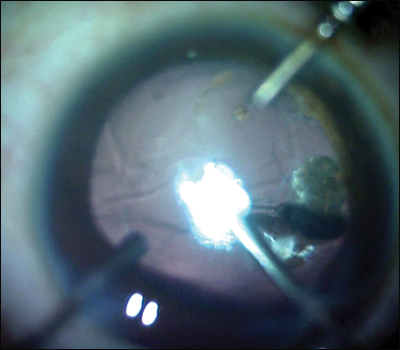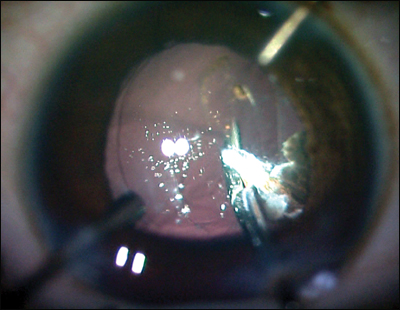Taking a closer look at persistent hyperplastic primary vitreous
PHPV presents with varied clinical features, and treatment depends on the type of presentation.
Persistent hyperplastic primary vitreous, or PHPV, is a form of persistent fetal vasculature, first described by Reese in 1955. The exact etiology of PHPV remains unknown, but it characteristically presents as unilateral leukocoria. PHPV is divided into subtypes: anterior, posterior and combined. In anterior PHPV, the remnant vascular stalk is seen attached to the posterior surface of the lens capsule, but it does not extend back to the optic nerve. Posterior PHPV occurs when the remnant vascular stalk is seen arising off the optic nerve but does not reach the lens. Posterior PHPV may be associated with developmental abnormalities of the optic nerve and retina. In the combined type, features of both anterior and posterior PHPV are often detected, and they give a mixed presentation.
Clinical features and pathology
Patients with PHPV present with varied clinical features depending on the extent of involvement of the ocular structure due to non-regression of fetal vasculature or a persistent hyaloid artery. They usually present with unilateral, rarely bilateral, leukocoria. Leukocoria is often the presenting feature, and it can result due to persistence of fibrovascular structure behind the lens; cataract; persistent dense pupillary membrane; or cloudy cornea secondary to raised IOP.








Children may present with a shallow anterior chamber and raised IOP secondary to the presence of fibrovascular tissue in ectopic locations due to the formation of peripheral anterior synechiae, posterior synechiae and a shift of the lens-iris diaphragm anteriorly. In PHPV, the fetal vasculature may invade the lens and cause a lenticular hemorrhage if perfusion persists. This eventually leads to cataract formation that can vary from partial to complete.
Patients may also present with decreased vision, microphthalmia, strabismus and amblyopia. Amblyopia may be a presenting symptom in PHPV due to a severe but previously undiscovered isolated posterior abnormality without an obvious anterior component.
Retinal detachment is often encountered with epiretinal fibrovascular tissue. When PHPV is associated with macular traction, degeneration and epiretinal membrane, there is usually severe ocular morbidity. The optic nerve may also be hypoplastic or dysplastic.
Investigation
A high-density echogenic band may be seen in the posterior segment of the globe extending from the posterior surface of the lens to the optic nerve head. Other features that can be seen are soft tissue fibrovascular infiltration of the vitreous body and retrolental tissue extending from the head of the optic nerve to the posterior surface of the lens; microphthalmia may be an associated feature. Arterial blood flow can also be detected within this vascular structure with the help of color Doppler.
A CT scan can be performed to clinch the diagnosis. It often helps to differentiate PHPV from retinoblastoma because the latter disease demonstrates calcification. Some surgeons also perform fluorescein angiography or an MRI that detects soft tissue involvement with greater details.
Differential diagnosis
PHPV needs to be differentiated from retinoblastoma, retinal detachment and often retinopathy of prematurity in cases of preterm infants.
Treatment
The treatment of the case depends upon the type of presentation. In cases with anterior PHPV presenting with cataract, a cataract extraction is performed (Figures 1 to 4). Performing an endodiathermy of the fetal vasculature to prevent intraoperative hyphema often follows this (Figure 5). The thick plaques are cut with micro-scissors, and vitrectomy is performed to prevent vitreous prolapse into the anterior chamber (Figures 6 to 8). Cases presenting with glaucoma are managed with medical/surgical treatment. A wide range of treatments and potential outcomes exist for PHPV because of the wide spectrum of presentation. Due to involvement of retinal and optic nerve abnormalities, posterior PHPV cases are usually associated with a poor visual outcome regardless of intervention. The final visual outcome also depends on the stage of surgical intervention and early detection. Cases with unilateral PHPV often need amblyopia management and refractive correction for proper visual rehabilitation.
- For more information:
- Amar Agarwal, MS, FRCS, FRCOphth, is director of Dr. Agarwal’s Eye Hospital and Eye Research Centre. Agarwal is the author of several books published by SLACK Incorporated, publisher of Ocular Surgery News, including Phaco Nightmares: Conquering Cataract Catastrophes, Bimanual Phaco: Mastering the Phakonit/MICS Technique, Dry Eye: A Practical Guide to Ocular Surface Disorders and Stem Cell Surgery and Presbyopia: A Surgical Textbook. He can be reached at 19 Cathedral Road, Chennai 600 086, India; email: dragarwal@vsnl.com; website: www.dragarwal.com.
- Priya Narang, MS, is the director of Narang Eye Care & Laser Centre, Ahmedabad, India. She can be reached at email: narangpriya19@gmail.com.
Disclosures: The authors report no relevant financial disclosures.









